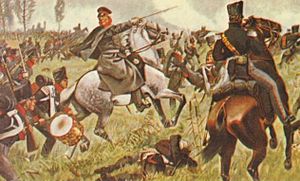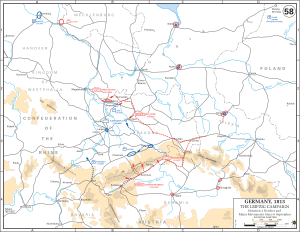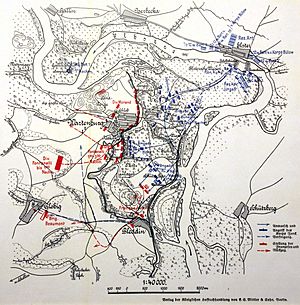Battle of Wartenburg facts for kids
Quick facts for kids Battle of Wartenburg |
|||||||
|---|---|---|---|---|---|---|---|
| Part of the German campaign of the Sixth Coalition | |||||||
 Yorck at Wartenburg |
|||||||
|
|||||||
| Belligerents | |||||||
| Commanders and leaders | |||||||
| Strength | |||||||
| 16,000 men, 64 guns | 13,000-15,000 men, 24 guns | ||||||
| Casualties and losses | |||||||
| 2,100 men | 1,900 men, 13 guns | ||||||
The Battle of Wartenburg was a key battle fought on October 3, 1813. It took place between the French army, led by General Henri Gatien Bertrand, and the Allied Army of Silesia, mainly made up of Prussian soldiers under General Ludwig von Yorck. This battle was important because it allowed the Allied forces to cross the Elbe river. This move helped set the stage for the much larger Battle of Leipzig later that month.
Why the Battle Happened
After losing a battle at Dennewitz, the French army, led by Marshal Ney, moved back to defend positions along the Elbe river. The Allied Army of the North, under Crown Prince Charles John of Sweden, followed carefully but didn't try to cross the river.
Meanwhile, Marshal Blücher made a bold move. He marched his Army of Silesia around Napoleon's forces in Dresden. His goal was to meet up with the Army of the North, cross the Elbe, and cut off Napoleon's supply lines to France.
Blücher needed a good place to cross the river. Major von Rühle found a spot near Elster. Here, the river curved around Wartenburg, and cannons on the other side could protect the crossing.
Blücher's army arrived at Elster on October 2. They built two floating bridges across the Elbe. The first Prussian soldiers, from Yorck's I Corps, started crossing. They found the ground very wet and marshy, making it hard to move. In front of them was a long raised path, called a dike, leading to Wartenburg. This dike was a perfect spot for the French to hide and defend.
The French commander, General Bertrand, thought his position was unbeatable. He had checked the area when the water was higher and believed it was too difficult for the enemy to attack.
The Battle Begins
General Bertrand set up his French troops. General Morand's French division was in Wartenburg, lined up along the dike. General Franquemont's Württemberg division, which had been badly hurt in an earlier battle, held a village called Bleddin on the right side. General Fontanelli's Italian division and a small group of cavalry were kept in reserve.
The battle started with a direct attack on Wartenburg by the Prussian brigade led by Steinmetz. The French fired heavily, forcing the Prussians back to the bridges. Blücher quickly rallied his troops and sent them forward again, but they still couldn't get past the dike.
Blücher also sent Mecklenburg's brigade to move along the riverbank. Their plan was to go around Bertrand's right side. By 11 AM, they met Franquemont's division near Bleddin, and a fierce fight began.
By 2 PM, the Württemberg soldiers were pushed out of Bleddin. The Prussian cavalry also defeated the French cavalry. Now, Wartenburg was being attacked from the east by Steinmetz and from the south by Mecklenburg.
The final push came from Horn's Prussian brigade. They moved through an orchard, crossed a stream, and got past two more dikes. They then attacked Fontanelli's Italian soldiers, who had been sent to help Morand.
With his side being attacked, Bertrand had to pull his troops back. The French IV Corps retreated first to Kemberg, then to Düben. There, they met up with another French corps. The French lost about 900 soldiers killed or wounded, and 1,000 men were captured, along with 13 cannons. The Prussians lost 1,900 soldiers killed or wounded, and 200 were missing.
What Happened Next
With the Army of Silesia now across the Elbe river, the Army of the North also crossed on October 4. These movements led to a series of important actions that ended with the huge Battle of Leipzig two weeks later.
Because of his bravery and success in this battle, General Yorck was later given a special noble title: Graf von Wartenburg.



